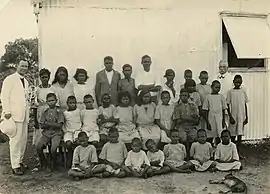| Kahlin Compound Darwin, Northern Territory | |||||||||||||||
|---|---|---|---|---|---|---|---|---|---|---|---|---|---|---|---|
 Children at the Kahlin Compound in 1921 | |||||||||||||||
 Kahlin Compound | |||||||||||||||
| Coordinates | 12°27′10″S 130°49′43″E / 12.452728°S 130.828682°E | ||||||||||||||
| LGA(s) | City of Darwin | ||||||||||||||
| |||||||||||||||
Kahlin Compound was an institution for part-Aboriginal people in Darwin in the Northern Territory of Australia between 1913 and 1939. After 1924, "half-caste" children were separated from their parents and other adults and moved to an institution at Myilly Point.
History
In 1913 the Northern Territory Protector of Aborigines, anthropologist Walter Baldwin Spencer decided to solve what he called the "half-caste problem" by rounding up hundreds of Aboriginal children and removing them from the "native camp". The Kahlin Compound and Half Caste Home was established on Lambell Terrace at Myilly Point, overlooking Mindil Beach in Darwin.[1] Spencer envisaged that the compound would be self-sufficient, providing housing, schooling and domestic training for each Aboriginal family. The whole compound was to be fenced with access for Aboriginal people and Departmental officials only.[2]
A 1923 Commonwealth parliamentary inquiry headed by the South Australian Senator John Newland included an investigation of conditions at the Compound. Newland recommended that it be moved to a site further from the town, but this did not happen (perhaps because the residents were a source of cheap labour).[3]
A subsequent inquiry appointed by the NT Administrator also recommended the establishment of a new compound be established and also that "half-caste" children should be separated from adults, in a separate institution where they could be disciplined and integrated into the [white] community. The new "Half-Caste Home" was opened at Myilly Point in 1924, and most of the Kahlin children were moved there.[3]
The compound was damaged in the 1937 cyclone.[4]
All residents were moved to the new Bagot Aboriginal Reserve in 1938. The Kahlin Compound closed in 1939 and was revoked as an Aboriginal Reserve on 3 July 1940.[3]
Re-use of site
.jpg.webp)
The site was used as an emergency hospital during a meningitis outbreak in 1940,[5] with patients housed in tents.[6] It then became part of the permanent Darwin Hospital grounds from 1942 until the hospital was demolished in the 1990s.[6][7]
An attempt made in 2003 to have the site listed on the Northern Territory Heritage Register as recognition of its cultural history was unsuccessful.[8]
In February 2017, the Northern Territory Government announced that a new $50 million museum would be built on the site, recognising both the hospital and in particular, the significance of the Kahlin Compound as part of Territory's multicultural heritage.[9][10] In October of that year, the site was found to be contaminated with asbestos, requiring additional remediation works.[11] The expensive museum proposal proved unpopular with the community, and the plans were abandoned in 2018.[12][9]
Removal of asbestos from the site was completed by 2021, with the area landscaped and opened as a public park including a large children's playground, skate park and basketball court.[13]
Commentary
The rounding up and deporting of Aboriginal people to such compounds across Australia has been described as a crime against humanity.[14]
See also
References
- ↑ "'The soul of Darwin': the story of the Kahlin Compound". Australian Broadcasting Corporation. Earshot, Radio National. 7 July 2015. Retrieved 27 September 2016.
- ↑ "Kahlin Compound: Background Historical Information". NT Heritage Register. Northern Territory Government. Retrieved 1 October 2016.
- 1 2 3 "Kahlin Compound (1913 - 1939)". Find and Connect. Australian Government. Retrieved 2 October 2016.
- ↑ "Cyclone at Darwin leaves trail of unroofed and ruined houses and lays waste surrounding country". The Sydney Morning Herald. No. 30, 951. 16 March 1937. p. 14. Retrieved 1 October 2016 – via National Library of Australia.
- ↑ "Epidemic dread in Darwin". The Sun. No. 9658. Sydney. 17 December 1940. p. 3 (Late Final Extra). Retrieved 1 October 2016 – via National Library of Australia.
- 1 2 Ellen Kettle (1986). "A brief history of Royal Darwin Hospital". Northern Territory Government Health Services Library ePublications. Royal Darwin Hospital. Retrieved 16 January 2022.
- ↑ "Kahlin Compound and Old Darwin Hospital site and Flagstaff Park" (PDF). Northern Territory Planning Commission. May 2014. Retrieved 16 January 2022.
- ↑ "Kahlin Compound". NT Heritage Register. Northern Territory Government. Retrieved 1 October 2016.
- 1 2 "$50 million museum at Darwin's Myilly Point". Council of Australasian Museum Directors. 28 September 2017.
- ↑ "Museum of the Northern Territory FAQ". Northern Territory Government. Retrieved 17 January 2022.
- ↑ Georgia Hitch (26 October 2017). "Asbestos discovered at old Darwin Hospital site, soon-to-be location of new museum". Australian Broadcasting Corporation.
- ↑ Emily Smith (22 April 2018). "Myilly Point museum plans scrapped following public outcry about $50m spend". Australian Broadcasting Corporation.
- ↑ "Myilly Point landscaping and playground". Department of Infrastructure, Planning and Logistics. Northern Territory Government. 22 February 2021. Retrieved 17 January 2022.
- ↑ "Australia accused of genocide against aborigines". The Independent. 22 October 2011. Retrieved 15 November 2021.